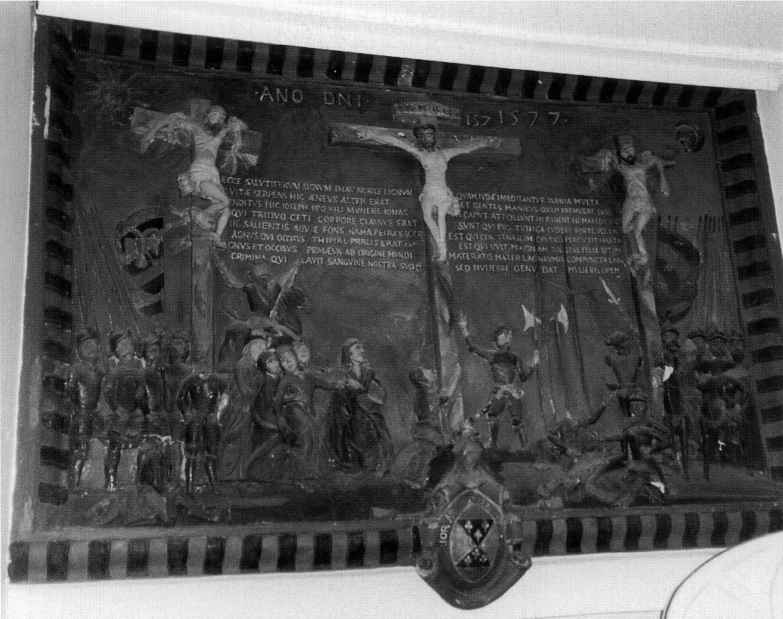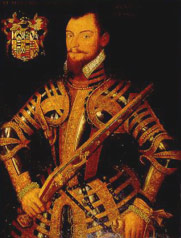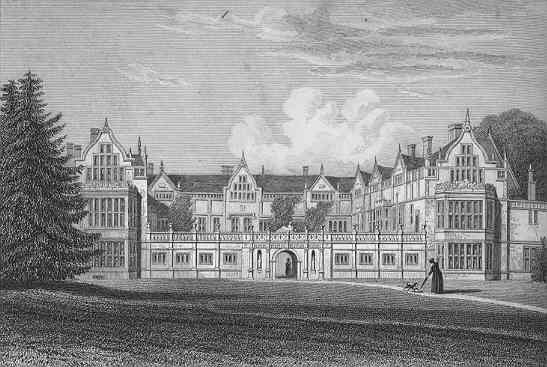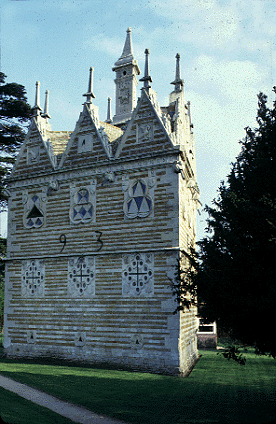Art and Architecture at the Tudor Court
In the reign of Henry VIII religious images were suppressed but the suppression was discretionary and varied from parish to parish. Edward VI introduced complete iconoclasm but he was only king for six years (1547-1553). Mary wanted to reverse all the changes and she ordered all religious images to be replaced. However, she was only queen for five years (1553-1558) when she died, maybe of cancer. Elizabeth was deliberately ambiguous in her attitude to religious images as she wanted to create a middle way to embrace as many people as possible. Elizabeth’s bishops continued the work of Edward however, but in the Royal Chapel Elizabeth kept images including a crucifix which was horrendous to her staunch Protestant courtiers.
The Catholic community wanted to rescue images so they took them from the churches and hid them in their houses but many were found and they were prosecuted. A statue of the dead Christ was found at Carpenter’s Hall during the blitz when a bomb exposed the statue that had been hidden under the floor.
On 10th April 1567 the Royal Commission for Causes Ecclesiastical in York found several local men guilty of hiding some of the images from their parish church to save them from the official policy of destruction. Their punishment was to do public penance (Borthwick Institute, York Ecclesiastical Commission Book, Act Books, R. VII. A. 3, ff104-105v):
… before Sonday next comynge … [they] shall bringe or cause to be broughte all the said Images to the Church stele of Ayskarth … and furthermore that they and every of them shalbe redy in the paryshe churche of Ayskarth … when the Curte ther shall begynnne to say the Communyon or Commoracion bare headed bare foted and bare legged havinge every one of themme a sheyte abowte him above his other apparell and shall knele all together in the quere of the same churche until suche time as the Curate shall go into the pulpytt to reade the Gospell at whiche time they and every of theme shall followe the Curate downe into the body of the churche and ther shall stande besydes the pulpitt with their faces towardes the people untill the Gospel be read the which beinge read they and every of theime shall say after the preyst with an audable voce as followethWhereas we good people forgyttinge and neclecting our dewtyes aswell to Almighty God as also to our soveraigne lady the Quenes and other hir highnes officers have throughe our negligence conceyled and kepte hyd certane Idoles and Images undefaced and lykewise certaine olde papisticall bookes in the Latyn tonge which some tyme dyd belonge to this paryshe churche of Ayskarth to the high offence of Almighty God the breache of the most godly lawes and holsome ordinances of this realme the greater danger of our owne sowles and the deceaving and snarring of the soules of the simple dor the whiche we are now most hartely sory
The whiche beinge done they shall put on their accustomed parell and so sone as the Communion or Commemoracion is done they shall go to the same Churche stele and ther burne all the Images before so many of the paryshioners as shalbe ther assembled…
A small group of people had rescued the images from Ayskarth (Yorkshire) church and the trail details are available in the Public Records Office. The sentence was the public penance described above. It was designed to humiliate as they had to go bare headed, bare foot anf bare legged to the church, read a penance out load and then publicly destroy the images.
It was done to make an example of them and to discourage others. However, external forces were at work and in 1569 there was the Northern Rebellion. The first ten years of Elizabeth reign had been fairly relaxed and there was a lot of toleration of Catholics. However, after the Rebellion the Pope, Pius V, decided that if he excommunicated Elizabeth and allowed Catholics to murder Elizabeth without committing a sin then this would assist a rebellion and enable Elizabeth to be replaced by Mary, Queen of Scotland. From this point on all Catholics became potential traitors and murderers and Elizabeth’s life was in continual danger. After the excommunication of 1570 hiding images became a state offence and was punished much more severely by prison or a very heavy fine or worse.
Some Catholics had held on to their images and some were smuggling images into the country so an Act was passed in 1571.
In 1571 Parliament passed An Acte agaynste the bringing in and putting in Execution of Bulls and other Instruments from the Sea of Rome (A. Lauders et al. (eds), The Statutes of the Realm (12 vols, London,1810-28), IV, pp.528-31). Although it was primarily a measure against the Pope’s bull of excommunication against Elizabeth, section four concerned the importation of:
Any Token or Tokens Thing or Thynges called or named by the Name of an Agnus Dei, or any Crosses Pyctures Beades or such lyke vayne and superstitious Thynges from the Bysshop or Sea of Rome, or from any person or persons aucthorized or clayming aucthorytie by or from the sayd Bysshop or Sea of Rome to consecrate or halowe the same…
Should any person deliver or cause to be delivered these ‘Pyctures’ or other objects to any subject of the realm that person would forfeit ‘lands, tenements, goods and chattels’.
Anyone possessing the Papal Bull was regarded as a traitor and was executed. The Act refers to pictures, tokens and beads that had been blessed by the Pope or a Catholic priest and possessing them enabled the state to take all your property including land.
So a Catholic sub-culture of illegal imagery developed.
1579, coastal guards were given a poster illustrating all the types of paintings, tokens, rosary beads, a cross and a picture of a kneeling saint so that they could recognise them. It became very dangerous to own even a single printed page of a saint. Such an image could be used for devotion and was easy to circulate and hid. They were even stuck on the wall to create a makeshift altar. A Jesuit priest described doing this in prison and so being able to celebrate mass. Being a Catholic priest was high treason. The atmosphere was like the Cold War of the 1950s, everyone was worried about ‘Reds under the beds’.
If you outwardly conformed, that is went to church once or twice a year then everything was OK. If you refused, like Sir Thomas Tresham, you were in trouble and he spent most of the last part of his life in prison and was only released when he was too old to create trouble. Sir Thomas Tresham was from a very old family, lower classes suffered much more.
Proportionally fewer people were burned at the stake in Britain compared to other European countries but restrictions were very tight. When there was a scare the known Catholics were rounded up and put in internment camps. The worst offence was hiding a priest as they were considered as foreign spies who were trying to create rebellion and other throw the monarch and the government (which they were). The government said people were not persecuted for their religion but for political reasons, for the security of the country.
Crosses, even without Christ, were not allowed in churches and Protestant priests would not even carry a simple wooden cross. When Jesuit priests were found they were asked to hand over their cross as it was known they always carried one.
We do not know but it is generally thought by scholars that until about 1580 most people were secretly inclined to Catholic beliefs but very few people made a public stand. Scotland went hard-line Protestant and Ireland was basically a war zone and so couldn’t be controlled.
Every time there was a Catholic scare the authorities would raid Catholic houses looking for and seizing objects that were banned. Such objects were evidence and so were recorded.
Public Record Office, State Papers (Domestic) 12/172, fol. 113: 27 Aug 1584
A report of the search made at Hoggesden [Hoxton] by order from hir Majestie & the Council, by Mr Justice Smith. Sir Thomas Tresams howse In it of persons wee fownd besides Sir Thomas Tresam him self
[List of names]
Moreover we found & brought away from the said howse the things foliwing
A popish painted crucifixe on a table hanging by the said ladies bedd stede
The Jesuites testament in english
The first book of Christian exercises
A booke of prayer and meditation
A painted crucifix upon orenge coloured satten
A picture of Christ upon canvas
Also we found there which we left behind A newe fashioned picture of Christ in a great table, and a tabernacle of sondrie painted images with leaves to fold serving as should seeme for a tabernacle or screene to stand upon an alter.
Illegal items included not just statues and paintings but needlework and rosary beads.
We have a few examples of images from illegal Catholic books that survived. For example the assumption of the Virgin Mary was banned as it is not mentioned in the Bible. However, all images of Christ, the Virgin Mary and saints were banned as it was thought they would become devotional images and it was thought they were forbidden by the second commandment.
Catholic engravings were printed on secret presses that were moved from house to house to stop them being discovered and pictures were also imported from abroad, such as Antwerp.
John Bucke produced a book with fold out pages of saints, priests and Popes.
Title page of a Catholic book showing a monstrance holding the consecrated bread.
There were also cheap woodcut prints for those who could not read, such as one showing the crowning of the Virgin Mary.
In one 1599 Antwerp book there is a picture of the assumption of the Virgin Mary.
Sir Thomas Tresham
He is wearing military uniform suitable for the Accession Day tilt and he is showing off the latest technology, a matchlock pistol. The matchlock and more advanced self igniting wheel lock were introduced about 1500 and the flintlock not until 1630 when it replaced all earlier weapons and continued in use for two centuries..
He was an outwardly conforming Catholic until 1580 when he took a public stand.

Unknown artist, Rushton Hall Crucifixion, 1577, plaster. On the east wall of a fairly small room above a door.
Triangular Warrener’s Lodge
In the only reference to this building Tresham calls it a warrener’s lodge and the is a rabbit warren alongside. He was also the leading seller of rabbits and rabbit pelts in Northamptonshire.
During the 1590s when it was built Tresham was imprisoned at Ely, a long way away.
We do not know if it was used for mass but one problem with the building is that if it had been raided there was no escape route and no place to hid.
Tresham was very proud of his ancestry and class and status tended to take precedence over religion. The building is partly a celebration of his ancestry.
The building celebrates the Trinity which was allowed as it was also a Protestant belief. In fact we have drawings by John Thorpe of Longford Castle (John Soane’s museum) showing a triangular lodge with the traditional image of the Trinity at its centre. Longford Castle was designed in 1580 so it pre-dates Tresham’s building by over ten years. John Thorpe did not design and building that were constructed but he went round the country surveying, drawing plans for existing building and copying existing plans. He did design a building based on his own initials, shaped as “IT”. In other words all these buildings were devices.
There is another design in John Thorpe’s book of a triangular building and there are other collections of drawings showing triangular, and circular buildings and buildings shaped as a cross.
The quotations across the eaves are in Latin from the Catholic Vulgate Bible but this may have been acceptable.
Lyveden New Build, was begun in 1594 and stopped in 1605 when Sir Thomas Tresham died of natural causes. As soon as the stonemasons heard of his death they downed tools as they knew they would not be paid and the building has never been completed. The device is a Greek cross with equal length arms so it suggest the Old Church. The frieze contains the instruments of the Passion and a design for a lantern survives. Inside there is a stone niche which looks as if it could have been designed for a statue, possibly of the Virgin Mary.
The instruments of the Passion however are Protestant as they are found on a 1598 book printed by a licensed printer and it would have been checked by the church. The picture also includes a chalice and what looks like a wafer above it.
The instruments of the Passion are also shown on a pre-Reformation indulgence engraving but at the top of the page is a Veronica Cloth (the cloth veronica used to wipe Christ’s face on the was to crucifixion imprinted with his face) but this story is not in the Bible.
Memorandum written by Sir Thomas Tresham in 1597 whilst imprisoned at Ely (British Library Add MS 39831, f5v):
In this chamber window west towards the orchard I have bestowed some painting, finding that Mr Browne had done the like in that window (and all my fellows in their chambers)…
And where some of my fellows having the crucifix painted in their chambers, the same was in their absence washed out and purposedly defaced, yet their arms, inscriptions etc to remain, I therefore have herein put nothing wherat offence is to be taken… Most thinges in this contened ar so perpecuus of them selfes that they nede no explaininge, and some ther ar which needeth explanation, for in impresees ys observed to bee so putt downe as differ from vulgar apprehension and yett wyll redely bee interpreted by men of skyll, especially yf skylled in that wherin the imprese or figuratore sene reacheth unto. Thes therfor tending to highest poyncts in divinitye, trynite &c. both forth of scripture and the fathers, also some poyntes forth of historye, musike, geometrye and arithmatik, fordermore using latyn, greeke and hebrewe, in all which to be skylfull ytt sorteth not with the greatest nomber…
The above text was discovered hidden in the wall of Rushton Hall in the 19th century when electricity was being put in. It was in a pile of hidden papers and explains that although his fellow inmates paint crucifixes on their cell walls he does not bother as they are painted over. Instead he paints an impresa that can only be interpreted by men of skill and versed in Latin, Greek and Hebrew. He was exploiting the lack of knowledge of his goalers to communicate his Catholic beliefs so he may have done the same with the Triangular Lodge.
Why did he build these buildings? For posterity and for a time when there was a Catholic monarch. They could also have been a retreat for private prayer as this was often a function of lodges for Protestant nobility.
Coughton Court (pronounced ‘Coeton’) has a 9′ x 6′ painted cloth showing Ely Cathedral, dated 1596, Christ with the instruments of the Passion at the top and the coats of arms at the bottom of all the Catholic gentlemen who had been imprisoned, when, where and the fine paid. It was produced by a Catholic for other Catholics and it was discovered in the 18th century rolled up in the attic.
The critical analysis of art work associated with dissenting Catholics has only been carried out recently as more interest has developed in the roll of minorities in artistic production.



